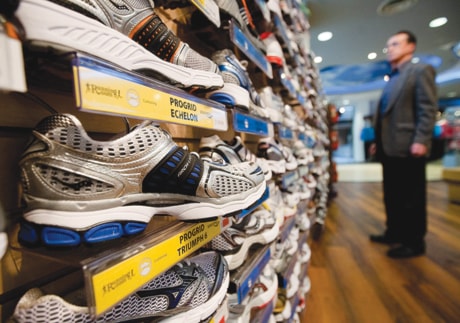TORONTO — Duff McLaren doesn’t need to unearth any old receipts to recall when he purchased his last pair of running shoes — the answer is etched right onto the soles.
After buying a new pair, he typically makes sure to write the date on the outer sole, and he tends to alternate between pairs to prevent them from wearing out too rapidly.
“I just make sure I know when I got them, so when I have a pair in August ’09 I’m saying, ‘OK, well, geez, maybe I should start to replace those,” said McLaren, a marathon coach with The Running Room who has been running for 20 years.
“There are signs the shoe is running out of life, so I just switch those and use those basically as a lifestyle walking around-in shoe, but not for any distance running.”
While it’s essential to ensure your workout shoes are the right fit for your feet, experts say it’s just as crucial to determine when to retire them, regardless of whether you’re a running enthusiast or more casual in your exercise routine.
McLaren’s shoe-dating approach isn’t unique.
Dr. Kel Sherkin, a podiatrist, tells his patients involved in sports to write the month and year on the inside tongue of their shoes so they can remember when they purchased them.
A standard rule of thumb is to replace them every 1,000 kilometres or so, he said.
“If you’re basically doing non-pounding exercise such as the elliptical, such as the bike, your shoes can last a little longer,” said Sherkin, co-author of “The Complete Handbook of Athletic Footwear.” “But if you’re doing pounding such as running either outside or inside, the shoe longevity will be decreased.”
For someone who isn’t necessarily keeping track of the number of clicks they’re covering in their kicks, Sherkin said one way to tell if the shoe is worn out is by looking at the midsole, the material between the outer sole and the top of the shoe.
“The midsole — that’s between the shoe itself and the outer sole — will wear faster than the actual outer sole will,” he said. “If you start seeing that the midsole is creased, has little creases in it, it tells you that the midsole is broken down, it’s time for repair.”
Exposure to heat and cold will also break down the midsole, he said.
Matthew Norminton, a buyer for The Running Room, said individuals should also be cognizant of the time spent in their shoes as part of other activities that contribute to their wear and tear.
“If you take the dog for a walk, that’s miles on your shoes. You go shopping in your shoes, that adds miles to your shoes,” he said. “It’s not just when you’re working out, it’s all the time that you’re wearing them.”
“Basically, what happens is you’re just wearing down the rebound factor and the resiliency in the cushioning properties of the shoes; so the more you stress the shoe, the more it gets worn down, and eventually, it just doesn’t rebound anymore and you lose that cushioning resiliency you had when you first bought the shoes.”
Dr. Mario Turanovic, president of the Canadian Podiatric Medical Association, said the most important factor to consider is the sudden or gradual development of pain during or after performance of an athletic or sports activity.
The breakdown of shoe structure — either the collapsing of the heel counter, the rest of the shoe or both — causes an unlevel platform that the body is standing on and has the potential to create a myriad of problems, he wrote in an email outlining common signs to be aware of.
The development of foot skin lesions, even if not painful, is a sign that the foot is no longer being held in the proper supported and protected position, he added.
But how do runners distinguish whether aches and pains are directly linked to the shoes? For McLaren, he said it’s a subconscious thing more than anything else.
“Obviously when you’re running, you get some knee pain you say, ‘Well, is that because I’ve been doing distance?’ And you start to think, ‘Gee, I’ve been running in the same shoes for a while so maybe it’s time to change them,”’ he said. “It’s just a little nuance more than anything else.”
“I know of people in the clinic saying, ‘Oh, well this hurts, this hurts,’ and I say to them first thing: ‘How long have you had your shoes?’ And then they start to think, ‘Oh yeah, maybe that’s what it is.”’
Sherkin said purchasing proper footwear to begin with is key. If shoes aren’t in proper condition, you are increasing the possibility of injury to the lower extremity, which extends from your hip to your foot, he said.
As a standard rule, all shoes, regardless of type, should be bought in the afternoon when the feet are at their most swollen, Sherkin said. Individuals should have their feet measured in the standing position and ensure the bigger foot is measured first.
When standing, there should be a thumbnail’s distance between the end of the longest toe and the end of the shoe, Sherkin said. If there isn’t, the shoe is too small.
Since most cross-trainers and athletic shoes are predominantly nylon, which doesn’t stretch, the shoe will either fit right off the bat or it won’t, Sherkin said.
McLaren agreed.
“There shouldn’t be such a thing as breaking in a pair of running shoes,” he said. “If they don’t feel right when you put them on then don’t wear them. The running shoes that you get, you should be able to run in them right away.”
McLaren said socks are also vitally important. He suggests steering clear of cotton sports socks which will retain the moisture and tend to build up a little friction and rub your feet. A number of wicking socks are available that will help take moisture off your feet, he said.
